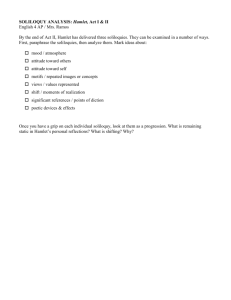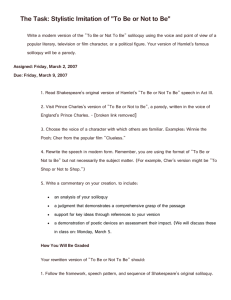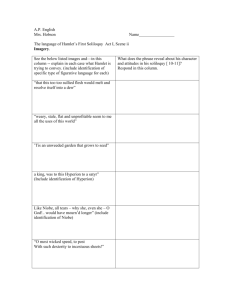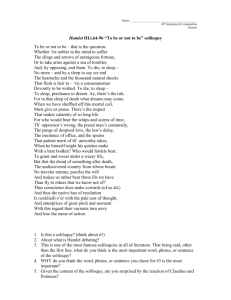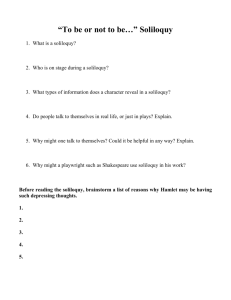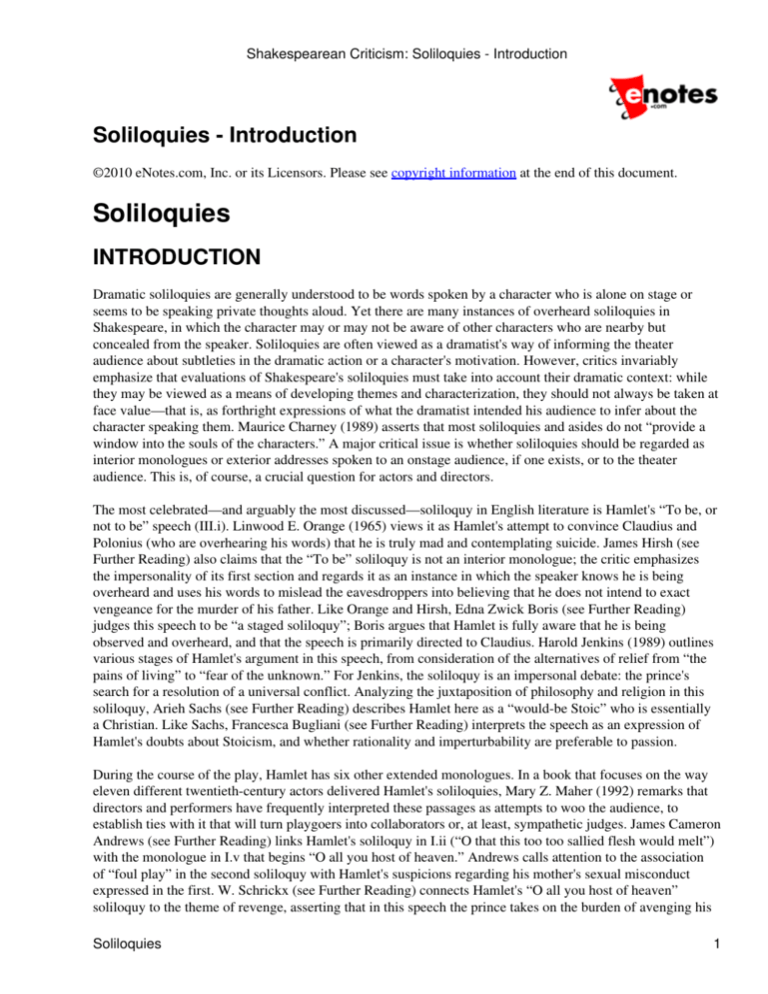
Shakespearean Criticism: Soliloquies - Introduction
Soliloquies - Introduction
©2010 eNotes.com, Inc. or its Licensors. Please see copyright information at the end of this document.
Soliloquies
INTRODUCTION
Dramatic soliloquies are generally understood to be words spoken by a character who is alone on stage or
seems to be speaking private thoughts aloud. Yet there are many instances of overheard soliloquies in
Shakespeare, in which the character may or may not be aware of other characters who are nearby but
concealed from the speaker. Soliloquies are often viewed as a dramatist's way of informing the theater
audience about subtleties in the dramatic action or a character's motivation. However, critics invariably
emphasize that evaluations of Shakespeare's soliloquies must take into account their dramatic context: while
they may be viewed as a means of developing themes and characterization, they should not always be taken at
face value—that is, as forthright expressions of what the dramatist intended his audience to infer about the
character speaking them. Maurice Charney (1989) asserts that most soliloquies and asides do not “provide a
window into the souls of the characters.” A major critical issue is whether soliloquies should be regarded as
interior monologues or exterior addresses spoken to an onstage audience, if one exists, or to the theater
audience. This is, of course, a crucial question for actors and directors.
The most celebrated—and arguably the most discussed—soliloquy in English literature is Hamlet's “To be, or
not to be” speech (III.i). Linwood E. Orange (1965) views it as Hamlet's attempt to convince Claudius and
Polonius (who are overhearing his words) that he is truly mad and contemplating suicide. James Hirsh (see
Further Reading) also claims that the “To be” soliloquy is not an interior monologue; the critic emphasizes
the impersonality of its first section and regards it as an instance in which the speaker knows he is being
overheard and uses his words to mislead the eavesdroppers into believing that he does not intend to exact
vengeance for the murder of his father. Like Orange and Hirsh, Edna Zwick Boris (see Further Reading)
judges this speech to be “a staged soliloquy”; Boris argues that Hamlet is fully aware that he is being
observed and overheard, and that the speech is primarily directed to Claudius. Harold Jenkins (1989) outlines
various stages of Hamlet's argument in this speech, from consideration of the alternatives of relief from “the
pains of living” to “fear of the unknown.” For Jenkins, the soliloquy is an impersonal debate: the prince's
search for a resolution of a universal conflict. Analyzing the juxtaposition of philosophy and religion in this
soliloquy, Arieh Sachs (see Further Reading) describes Hamlet here as a “would-be Stoic” who is essentially
a Christian. Like Sachs, Francesca Bugliani (see Further Reading) interprets the speech as an expression of
Hamlet's doubts about Stoicism, and whether rationality and imperturbability are preferable to passion.
During the course of the play, Hamlet has six other extended monologues. In a book that focuses on the way
eleven different twentieth-century actors delivered Hamlet's soliloquies, Mary Z. Maher (1992) remarks that
directors and performers have frequently interpreted these passages as attempts to woo the audience, to
establish ties with it that will turn playgoers into collaborators or, at least, sympathetic judges. James Cameron
Andrews (see Further Reading) links Hamlet's soliloquy in I.ii (“O that this too too sallied flesh would melt”)
with the monologue in I.v that begins “O all you host of heaven.” Andrews calls attention to the association
of “foul play” in the second soliloquy with Hamlet's suspicions regarding his mother's sexual misconduct
expressed in the first. W. Schrickx (see Further Reading) connects Hamlet's “O all you host of heaven”
soliloquy to the theme of revenge, asserting that in this speech the prince takes on the burden of avenging his
Soliloquies
1
Shakespearean Criticism: Soliloquies - Introduction
father's death, even though his religious beliefs incline him to leave vengeance to divine providence. Stephen
Booth (see Further Reading, 2002) offers a close reading of the “O, what a rogue and peasant slave am I!”
soliloquy at the close of Act II, scene ii. Booth emphasizes the complexity of this speech, its lack of clarity,
and the richness of its language. Both Fredson Bowers (1962) and Maurice Charney (1977) evaluate Hamlet's
monologue in Act III, scene ii that follows the dumb show of “The Murder of Gonzago” and which begins
“'Tis now the very witching time of night.” Bowers argues that the function of this speech is to inform the
audience that Hamlet's confrontation with Gertrude in the following scene is linked to his hope that he can
make his mother see the incestuous nature of her marriage to Claudius. Charney similarly associates this
soliloquy with the closet scene (III.iv), but in contrast to Bowers, he argues that the speech demonstrates that
Hamlet has become so contaminated by the idea of revenge that his attitude toward his mother is dominated
by cruelty and thoughts of matricide. Gideon Rappaport (1987) analyzes Hamlet's “Now might I do it pat”
soliloquy (III.iii), as Claudius kneels in an attempt to pray. Emphasizing the importance of reading this
passage in relation to its dramatic context, the critic contrasts Hamlet's apparent rationality here with the
prince's corruption and descent into evil as he struggles to determine how to pursue an ethical course of action
in a universe that is “morally complex.” Anthony J. Gilbert (1995) assesses Hamlet's “How all occasions do
inform against me” soliloquy (IV.iv) with respect to the question of whether dramatic soliloquies,
Shakespeare's and others', represent moments of truth telling. Gilbert calls attention to what he regards as
Hamlet's evasive, ambiguous language in this passage, concluding that the speech demonstrates that “Hamlet
is incapable of knowing why he does not act.” Ralph Berry (1989) argues that a principal function of Hamlet's
soliloquies is to impose “his viewpoint upon the audience” by speaking to it directly, as if its members were
psychological counselors or analysts. Both Berry and Rappaport address the question of why Hamlet has no
monologues in Act V; their conclusions are similar: the absence of externalized complaints signals that by this
point in the play the prince has matured, finally acknowledging his responsibility to take action.
Commentary on soliloquies in other Shakespearean tragedies include evaluations of those spoken by Macbeth,
Othello, and Juliet. Horst Breuer (see Further Reading), S. S. Hussey (1982), and Gilbert bring different
perspectives to bear on Macbeth's monologues. Breuer analyzes the “Tomorrow, and tomorrow, and
tomorrow” speech (V.v) with reference to medieval and Renaissance concepts of time; in the Middle Ages,
the critic argues, time was a symbol of order and stability, but in the early modern era time is disorderly and
fragmented. In Breuer's judgment, a large measure of the despair and alienation Macbeth expresses in this
soliloquy is related to a loss of identity and a hopeless view of the future. In an essay on the development of
Shakespeare's soliloquies, Hussey discusses several of Macbeth's, with particular attention to the rhythm and
rhetoric of the first, which begins “This supernatural soliciting / Cannot be ill, cannot be good” (I.iii), and the
second, “If it were done when 'tis done” (I.viii). By contrast, Gilbert focuses on this second soliloquy, reading
it as a disclosure of Macbeth's “desperate search for security” but also as evidence of his capacity for honesty
and self-knowledge. Gilbert also remarks on Othello's “It is the cause” soliloquy (V.ii), calling attention to its
ambiguities and fallacious reasoning, and characterizing these as indications of the Moor's evasion or
repression of the truth. James Hirsh (2003) evaluates “implicitly overheard” soliloquies and asides in Romeo
and Juliet, assessing them in terms of what he claims were the prevailing dramatic conventions for such
speeches at the time the play was written. Similarly concerned with dramatic conventions, Gary M. McCown
(see Further Reading) explicates Juliet's soliloquy at the opening of Act III, scene ii in the context of classical
and medieval wedding lyrics; the critic proposes that Shakespeare altered the usual style of such lyrics to
achieve a deeper sense of sadness and paradox.
Among the historical figures Shakespeare recreated, Richard III is an eminent focus of commentators who
study Shakespeare's soliloquies. Lawrence W. Hugenberg, Sr., and Mark J. Schaefermeyer (1983), James
Schiffer (2000), and Igor Shaitanov (see Further Reading) offer varying points of view of Richard's
monologues. Hugenberg and Schaefermeyer discuss Richard's soliloquies in both Richard III and Henry VI,
Part 3, contending that in these speeches he has two audiences: himself and the people witnessing the play.
Moreover, the critics assert that the soliloquies serve to disclose Richard's motives, to demonstrate his creation
of a self-image, and to establish a bond between Richard and the theater audience. Contrasting Richard's first
INTRODUCTION
2
Shakespearean Criticism: Soliloquies - Introduction
soliloquy, “Now is the winter of our discontent” (I.i.), with his last, “O outward conscience, how doest thou
afflict me!” (V.iii), Schiffer points out that while the first soliloquy is apparently a direct address to the
audience, the last is seemingly an interior monologue. The critic suggests that Richard's increasingly
fragmented self, reflected in the last soliloquy, mirrors the audience's divided responses to the king:
throughout the play we are drawn to and repelled by his persona. Shaitanov centers his attention on Richard's
first soliloquy, especially its semantics. The critic urges readers and audiences to pay close attention to the
effect of the repetition of vowel sounds in the speech and to its combination of personal and impersonal tones.
Another eminent soliloquist in Shakespeare's history plays is Prince Hal; Dale C. Uhlmann (1984) and Marc
Grossman (1995) both evaluate his “I know you all” soliloquy in Act I, scene ii of Henry IV, Part 1.
Uhlmann contends that this speech is a complex argument that moves from the general to the specific, and
remarks on its sonnet-like structure as well as its rhetoric. Grossman maintains that the prince's argumentation
here is specious, pointing out that the passage should be read or heard with close attention to the
circumstances in which Hal delivers it.
Copyright Notice
©2010 eNotes.com, Inc.
ALL RIGHTS RESERVED.
No part of this work covered by the copyright hereon may be reproduced or used in any form or by any means
graphic, electronic, or mechanical, including photocopying, recording, taping, Web distribution or information
storage retrieval systems without the written permission of the publisher.
For complete copyright information, please see the online version of this work:
http://www.enotes.com/shakespearean-criticism
Copyright Notice
3

